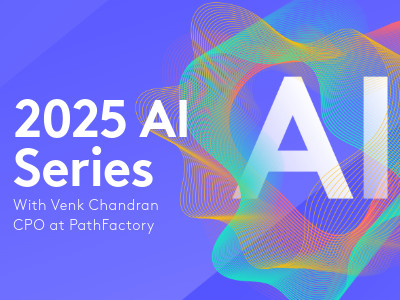Understanding AI Technology: Part 1
AI Extraction: The Secret Sauce Behind Content Personalization

By: Venk Chandran, Chief Product Officer &
Srinivasan Margabandhu, Executive Director of AI Research
Ever wondered how AI can personalize your B2B experience? It all starts with extraction – taking data from different sources and organizing it so AI can understand and use it. Think of it like squeezing oranges for juice: you need the good stuff (structured data) to make something worthwhile.
Great Extraction allows Agents to ‘retrieve’ the right answer
How does Extraction Work?
AI-powered data extraction is a sophisticated process that automates the retrieval and structuring of information from various sources. Here are a few key points on how extraction works in AI:
1. AI data extraction begins with preprocessing, where raw data is cleaned, normalized, and prepared for analysis
2. Machine learning algorithms, including supervised, unsupervised, and semi-supervised learning, are employed to identify patterns and extract relevant information from the data
3. Natural Language Processing (NLP) techniques are used to understand and interpret human language, enabling the extraction of meaningful insights from text-based sources
4. For image-based data, computer vision algorithms are applied to recognize and extract visual elements
5. The AI models categorize the extracted information into structured formats, making it easier to analyze and utilize
6. Advanced AI systems incorporate feedback loops, allowing the models to learn from past extractions and improve their performance over time
By leveraging these techniques, AI data extraction significantly enhances the speed, accuracy, and efficiency of information retrieval compared to traditional manual methods.
Why’s Extraction Important?
Structured data is the fuel for AI and machine learning. The more structured the data, the easier it is to find patterns and apply algorithms. Even the latest AI innovations, like generative AI, need some order to work their magic.
Extraction Challenges
Not all extraction is created equal. Different media types (like videos, PDFs, or images) have unique properties that make extraction tricky. That’s why AI companies are constantly improving their extraction game.
Key Points for Extraction
- Content Types: We live in a multi-media world, so extraction needs to handle various formats like HTML, PDFs, videos, and more.
- Complex Data and Formatting: Think tables, images, and multi-column layouts – these can be tough nuts to crack for extraction.
- Header/Footer Data: Headers and footers often contain repetitive text that needs to be filtered out.
- Structure and Punctuation: Punctuation is crucial for conversational AI and answering questions based on context.
- Extraction Scale: How to extract anywhere from 10-1M pieces of diverse content?
- Observability: How do we ensure that extraction is working? What happens when extraction fails.
Extraction and Marketing
For marketers, good extraction is essential. Bad extraction leads to poor recommendations and inaccurate responses in customer conversations. It’s like having a recipe with the wrong ingredients – the end result just won’t be good.
Extraction challenges are often why agent conversations tend to fail. And it’s important to ensure that Agents not only extract content, but can do it quickly and at scale.
Extraction at ChatFactory
At PathFactory, we’ve done a ton of work to make sure that we extract the purest form of juice from the oranges. This is the secret sauce behind our ability to provide the most personalized, trusted and relevant AI conversations and content for your buyers.
Squeezing the Juice
Our extraction pipelines are tailored to specific content types. While many other AI platforms use standard tools or a one-size-fits-all all approach, we customize a range of standard extraction tools such as Firecrawl and Diffbot, and tune them to the unique extraction needs of different types of content including dynamic HTML pages, social media, and PDF’s.
A couple of examples of this type of content specific extraction that are critical for accurate structured data are HTML and PDF’s. For dynamic HTML our extraction engine is tuned to filter out the “noise” like the information in HTML-embedded images that is not always relevant and may primarily contribute to the aesthetics of the webpage. For PDFs, our extraction process goes well beyond standard PDF extractors. We use vision-based LLMs, where each page of the PDF is processed through the LLM to extract all relevant information. This vision-based approach ensures that we extract data from tables, embedded images, and infographics without losing semantic meaning.
We continuously improve our pipeline. Some of the additional features in the pipeline include:
- Agent-Based Approach to Extraction: Developing a collection of parsers, that are dynamically used to parse and extract data from different content formats.
- Ensemble Approach for Parser Selection: Applying reflection and reasoning mechanisms to automatically select the most suitable parser for the content.
- Customized Knowledge Graph: Creates rich, detailed relationships between data points.
- Continual Feedback Mechanism: Introducing an evaluation-driven feedback loop to continually improve the extraction process based on performance assessments.
Continual Feedback Mechanism: Introducing an evaluation-driven feedback loop to continually improve the extraction process based on performance assessments.
Serving Up Sweet Results
Once we have the freeze squeezed data, we need to serve it up accurately and in the right context. To do this we need to also use extraction on user queries so we can understand what our visitors want to know and give them the best personalized answer.
Our finely tuned extraction also works on the conversation level where word-level algorithms extract key-phrases from questions and automatically assign importance scores to each of them resulting in better topic models that drive answers and recommendations.
Our Agents also create a standardized engagement score as a way to understand what visitors are telling us and what their intent is, so we can provide better personalized responses to questions and anticipate what questions they might be interested in asking.
Finally, our extraction engine can put all questions and answers together to create a comprehensive knowledge graph and language model to help our Agent Platform get smarter and smarter every time it helps someone with their questions.
The Bottom Line
As marketers, you’re constantly creating content. Extraction is critically important to delivering a good AI experience for your customers. Without the ability to extract and structure the data in your content, you only have a bag of words with no deep connection between them, which leads to a disappointing experience. Good extraction helps you get the most out of your content and AI investments. So, when you’re thinking about AI, don’t forget to ask about extraction. Make sure the juice is worth the squeeze!
